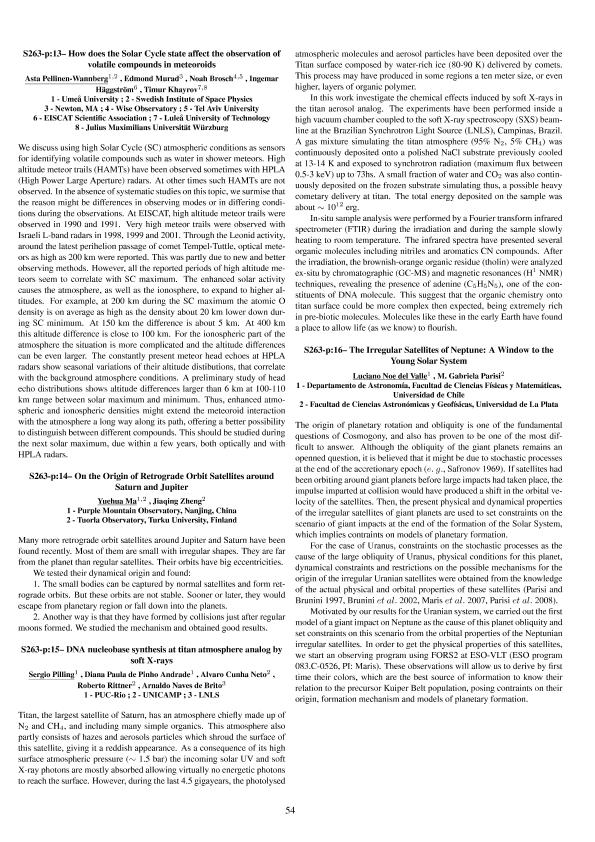Mostrar el registro sencillo del ítem
dc.contributor.author
Parisi, Mirta Gabriela

dc.contributor.author
del Valle, Luciano Noe
dc.contributor.other
Fernandez, Julio A.
dc.contributor.other
Lazzaro, Daniela
dc.contributor.other
Prialnik, Dina
dc.contributor.other
Schulz, Rita
dc.date.available
2024-04-05T18:26:01Z
dc.date.issued
2009
dc.identifier.citation
The Irregular Satellites of Neptune: a window to the Young Solar System; IAU Symposium 263: Icy Bodies of the Solar System; Río de Janeiro; Brasil; 2009; 54-54
dc.identifier.isbn
9780521764889
dc.identifier.uri
http://hdl.handle.net/11336/232207
dc.description.abstract
The origin of planetary rotation and obliquity is one of the fundamental questions of Cosmogony, and also has proven to be one of the most difficult to answer. Although the obliquity of the giant planets remains an openned question, it is believed that it might be due to stochastic processes at the end of the accretionary epoch (e. g., Safronov 1969). If satellites had been orbiting around giant planets before large impacts had taken place, the impulse imparted at collision would have produced a shift in the orbital velocity of the satellites. Then, the present physical and dynamical properties of the irregular satellites of giant planets are used to set constraints on the scenario of giant impacts at the end of the formation of the Solar System, which implies contraints on models of planetary formation. For the case of Uranus, constraints on the stochastic processes as the cause of the large obliquity of Uranus, physical conditions for this planet, dynamical constraints and restrictions on the possible mechanisms for the origin of the irregular Uranian satellites were obtained from the knowledge of the actual physical and orbital properties of these satellites (Parisi and Brunini 1997, Brunini et al. 2002, Maris et al. 2007, Parisi et al. 2008). Motivated by our results for the Uranian system, we carried out the firstmodel of a giant impact on Neptune as the cause of this planet obliquity and set constraints on this scenario from the orbital properties of the Neptunian irregular satellites. In order to get the physical properties of these satellites, we start an observing program using FORS2 at ESO-VLT (ESO program 083.C-0526, PI: Maris). These observations will allow us to derive by first time their colors, which are the best source of information to know their relation to the precursor Kuiper Belt population, posing contraints on their origin, formation mechanism and models of planetary formation.
dc.format
application/pdf
dc.language.iso
eng
dc.publisher
Cambridge University Press

dc.rights
info:eu-repo/semantics/openAccess
dc.rights.uri
https://creativecommons.org/licenses/by-nc-sa/2.5/ar/
dc.subject
Planets and Satellites: general
dc.subject.classification
Astronomía

dc.subject.classification
Ciencias Físicas

dc.subject.classification
CIENCIAS NATURALES Y EXACTAS

dc.title
The Irregular Satellites of Neptune: a window to the Young Solar System
dc.type
info:eu-repo/semantics/publishedVersion
dc.type
info:eu-repo/semantics/conferenceObject
dc.type
info:ar-repo/semantics/documento de conferencia
dc.date.updated
2024-02-22T14:28:15Z
dc.journal.volume
263
dc.journal.pagination
54-54
dc.journal.pais
Estados Unidos

dc.journal.ciudad
Cambridge
dc.description.fil
Fil: Parisi, Mirta Gabriela. Universidad Nacional de La Plata. Facultad de Ciencias Astronómicas y Geofísicas; Argentina. Provincia de Buenos Aires. Gobernación. Comisión de Investigaciones Científicas. Instituto Argentino de Radioastronomía. Consejo Nacional de Investigaciones Científicas y Técnicas. Centro Científico Tecnológico Conicet - La Plata. Instituto Argentino de Radioastronomía; Argentina
dc.description.fil
Fil: del Valle, Luciano Noe. Universidad de Chile; Chile
dc.relation.alternativeid
info:eu-repo/semantics/altIdentifier/url/http://www.astronomia.edu.uy/congresos/symp263/symp263_program.htm
dc.relation.alternativeid
info:eu-repo/semantics/altIdentifier/url/http://www.astronomia.edu.uy/congresos/symp263/
dc.relation.alternativeid
info:eu-repo/semantics/altIdentifier/url/https://inspirehep.net/conferences/1406610
dc.conicet.rol
Autor

dc.coverage
Internacional
dc.type.subtype
Simposio
dc.description.nombreEvento
IAU Symposium 263: Icy Bodies of the Solar System
dc.date.evento
2009-08-03
dc.description.ciudadEvento
Río de Janeiro
dc.description.paisEvento
Brasil

dc.type.publicacion
Journal
dc.description.institucionOrganizadora
International Astronomical Union
dc.source.revista
Proceedings of the International Astronomical Union Symposia and Colloquia
dc.date.eventoHasta
2009-08-07
dc.type
Simposio
Archivos asociados
